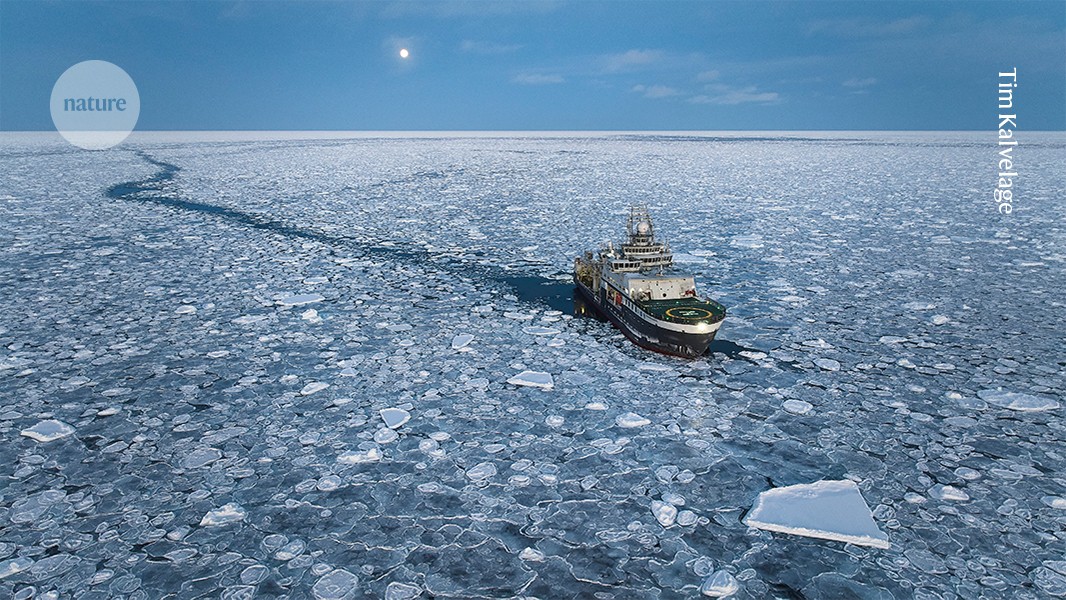Eight hundred kilometres north of the Arctic Circle, the research vessel Kronprins Haakon drifts quietly through a thick pack of ice floes. The sky and sea are bathed in purple morning light as Alexandra Stephens, a PhD student at the University of Toronto Mississauga, Canada, pilots a drone over the frosty expanse, hunting for heat.
Although it doesn’t look like it, the Arctic waters are balmy in February, relative to the air temperatures, which can fall below −30 °C. On the screen of Stephens’s remote control, the pancake-shaped floes show up in the thermal images as dark circles, whereas open water and thin ice glow bright orange, indicating energy escaping from the ocean into the frigid polar air.
The transfer of heat from ocean to atmosphere is at the heart of one of the most important components of Earth’s climate — a system of currents that snakes across the entire length of the Atlantic Ocean and transports warm water from the tropics to high northern latitudes. Known by the unwieldy name of the Atlantic Meridional Overturning Circulation (AMOC), this network of currents affects weather conditions for billions of people around the world. It’s the reason that north-western Europe is relatively mild in the winter and much warmer than Labrador in Canada, which is at a similar latitude.

Alexandra Stephens pilots a drone that collects data on heat escaping from the ocean.Credit: Tim Kalvelage
But scientists are increasingly concerned that this crucial current system is weakening as the planet is getting hotter because of greenhouse-gas pollution building up in the atmosphere. Some computer climate simulations warn that the AMOC could reach a tipping point in the twenty-first century and lose much of its strength. This would have catastrophic impacts across the globe; one study published last year projects that temperatures in north-western Europe could drop by as much as 15 °C, plunging the region into a new ice age, while the southern hemisphere would suffer more severe warming1. It also suggests that a near-collapse of the AMOC would drive disruptive changes in rainfall in the Amazon basin. “The effects of an AMOC collapse will be so extreme that it will be difficult for us to adapt,” says physical oceanographer Henk Dijkstra at Utrecht University in the Netherlands, a co-author of the study.
Despite its importance, the AMOC is one of the big unknowns in projections about Earth‘s future climate. Researchers have little information about how the current system is changing — particularly in the polar North Atlantic, a key region for the AMOC. That’s what brought the Norwegian ice-breaker RV Kronprins Haakon to the western Greenland Sea in February as part of a project known as ROVER, which is funded by the European Union. With its strengthened hull, the ship can venture into the ice-covered region to collect precious data on how the AMOC might evolve.

On the bridge of Kronprins Haakon at dawn, chief scientist Kjetil Våge (left) and captain Hallgeir M. Johansen discuss the route through the sea ice. Credit: Tim Kalvelage
“This is a very sparsely sampled area, especially in winter when hardly anyone ever goes out here,” says Kjetil Våge, a physical oceanographer at the Bjerknes Centre for Climate Research in Bergen, Norway, who is leading the ROVER mission. He suspects the loss of sea ice near Greenland caused by global warming might actually help to stabilize the AMOC and prevent it from slowing as much as people fear.
I joined the ROVER expedition in February as it collected data that will take the pulse of the AMOC and help researchers to assess how it will change in coming decades.
Crossing currents
As the RV Kronprins Haakon left Norway’s Svalbard archipelago at the start of the expedition, the Arctic was still veiled in the perpetual darkness of the polar night. The far-reaching influence of the AMOC was obvious as we crossed Fram Strait, which separates Svalbard and Greenland (see ‘Winter journey’). On the first part of the journey, the ship passed through northward-flowing Atlantic waters that kept the ocean ice free. As we left that current, the Kronprins Haakon quickly encountered heavy pack ice from the Arctic Ocean drifting south.
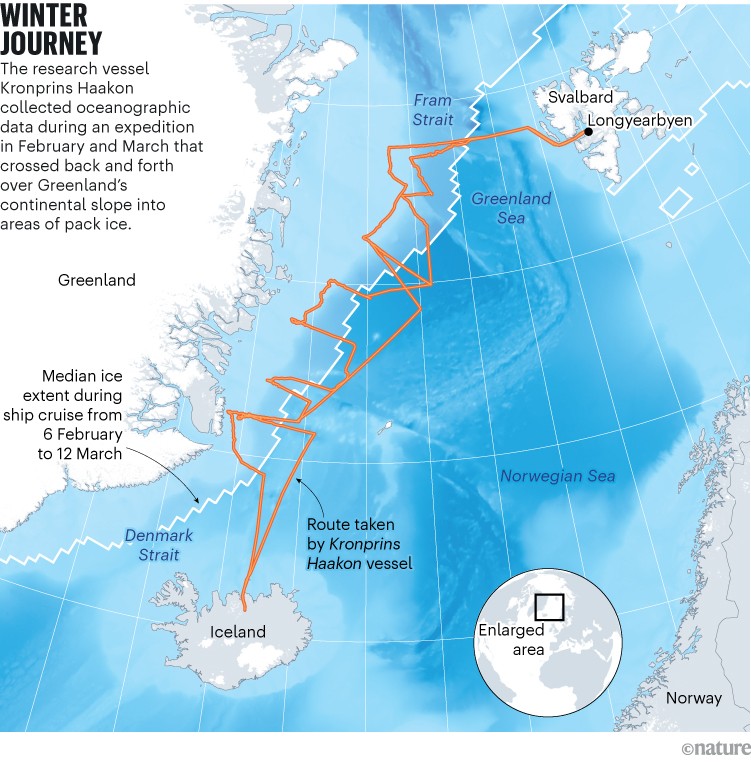
Sources: Bathymetry: GEBCO; Ice extent and glaciers: NSIDC; Greenland ice sheet: ESA Glaciers CCI; Cruise data: Kjetil Våge
The AMOC is often described as a conveyor belt — a highly simplified but apt description because its upper currents and deeper ones move in opposite directions. In the Northern Hemisphere, the surface strands, which include the Gulf Stream, carry warm and salty water from the equator towards the pole. At high latitudes that water releases huge amounts of heat into the atmosphere that helps to warm parts of Europe in winter.
When the surface water of the AMOC cools off, it becomes dense enough to sink into the abyss in the North Atlantic near Greenland, which locks away huge amounts of carbon dioxide and supplies oxygen to the deep sea. At depth, the water flows south until it resurfaces again near Antarctica (see ‘Heat flows’).
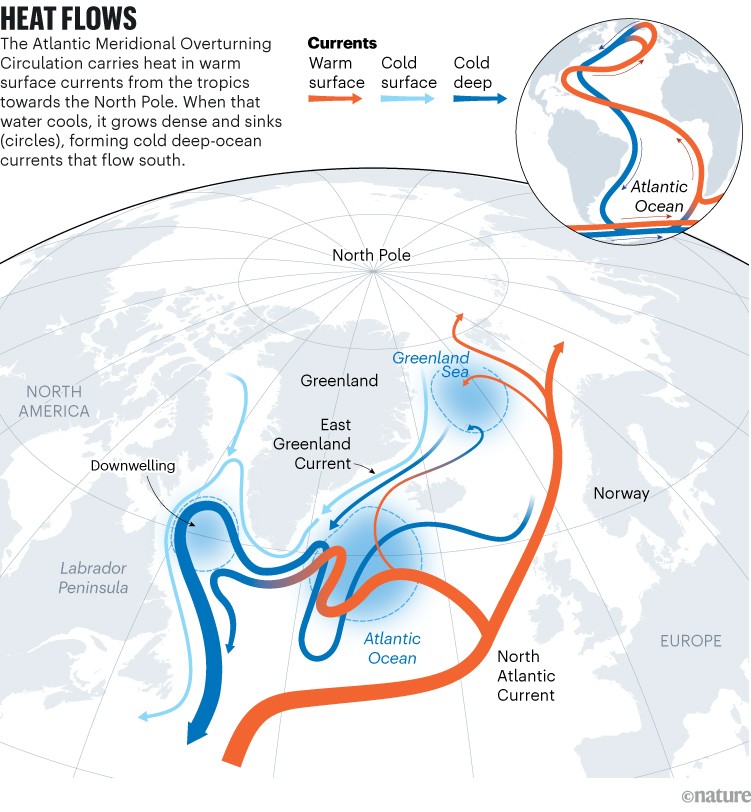
Sources: S. Rahmstorf Oceanography 37, 16–29 (2024)/R. Curry and C. Mauritzen Science 308, 1772–1774 (2005)
Computer climate simulations suggest that global warming could disrupt the current system in several ways: as air temperatures in the Arctic and subarctic increase, the surface water doesn’t cool as much in winter, which keeps it from getting as dense as it normally would. Another factor at play is the melting of sea ice and the Greenland ice sheet. This melting adds fresh water to the uppermost ocean, reducing the density of the surface water even more. These changes inhibit the sinking that drives the AMOC2.
It’s not just a theoretical concern that this could happen: evidence from Earth’s past suggests that there were abrupt shifts in the strength of the AMOC between ice ages and warm periods3.
Concerns about the future prompted scientists to start monitoring the Atlantic Ocean in the early 2000s. To track what is happening with the AMOC, international research consortia have anchored instruments to the sea bed at various latitudes across the ocean’s basin to measure water temperature, salinity and current speed. The longest-running programme, RAPID-MOCHA, has gauged the strength of surface and deep-ocean currents of the AMOC since 2004 in the subtropics at 26° N. Another effort, called OSNAP, monitors the AMOC at more than 50 sites from Labrador to South Greenland to Scotland.
So far, their records show considerable variability but no consistent changes in how much water the AMOC moves4,5. The time span of the observations is simply too short to make out a trend, says Susan Lozier, a physical oceanographer at the Georgia Institute of Technology in Atlanta, and head of OSNAP. “We are in this messy middle of trying to understand what is happening with the overturning circulation.”
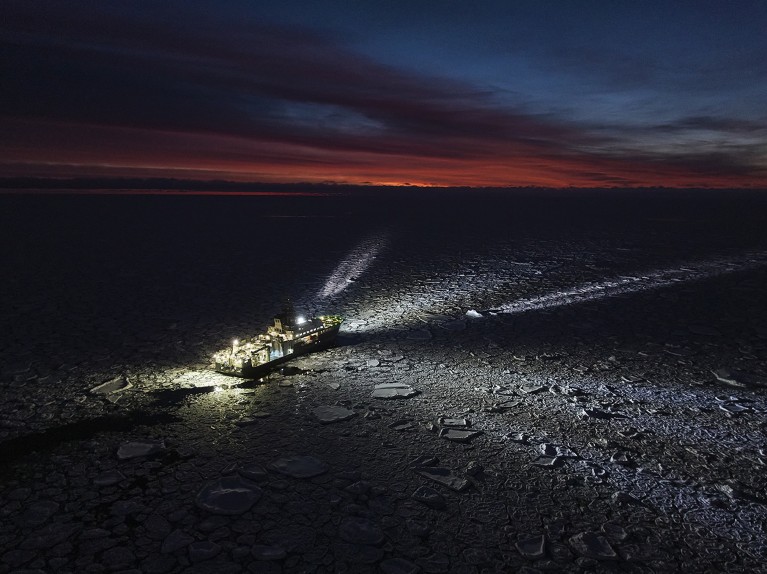
The ship travels through the pack ice of the Greenland Sea near 76° N at dawn.Credit: Tim Kalvelage
Because researchers have only two decades of direct current measurements, they rely on indirect means of gauging the strength of the AMOC. For example, records of sea surface temperatures show that the subpolar North Atlantic has cooled since the 1950s while the ocean as a whole has warmed: some scientists interpret the cooling as a sign of a reduction in the amount of warm water from the subtropics reaching the region, which would correspond to a 15% decline in the strength of this current system6. Others, however, have found the AMOC to be stable for the past few decades7.
Several modelling studies in the past few years warn that the AMOC could weaken drastically in the near future — up to the point of causing a near-shutdown. A collapse would not happen abruptly but would take 50–100 years, says Stefan Rahmstorf, a climate scientist at the Potsdam Institute for Climate Impact Research, Germany. Beyond a crucial tipping point, however, a further decline is unstoppable. “I think there is a 50–50 chance that we will pass the tipping point this century,” he says.
The idea that the AMOC is heading for collapse is controversial. The question is, can climate models realistically simulate the present and therefore produce reliable forecasts? To do so, scientists need observations to evaluate and refine their models, says Ben Moat, a physical oceanographer at the National Oceanography Centre in Southampton, UK, and one of the heads of RAPID-MOCHA. “Observations are critical to our understanding of what‘s happening to the future AMOC.”
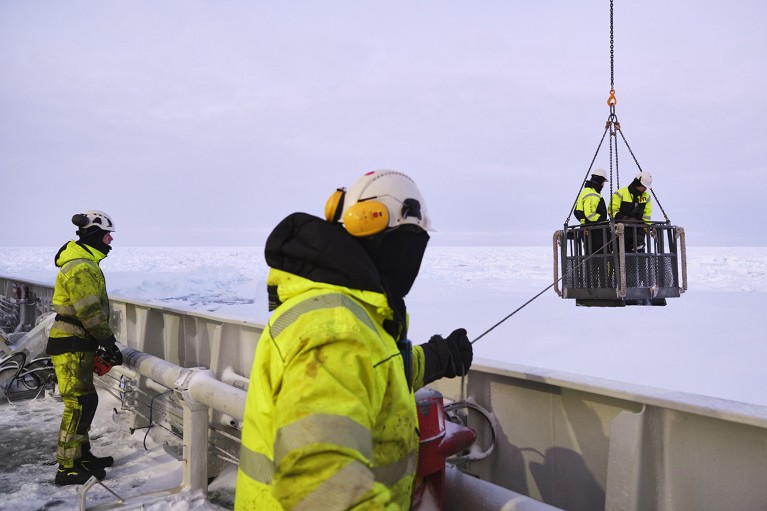
Scientists deploy a buoy in the Greenland Sea to study sea ice.Credit: Tim Kalvelage
Våge thinks that processes in the Nordic Seas north of Iceland, which are not well resolved by current climate models, could help to decide the fate of the AMOC. That’s why his team ventured into the icy waters of the Arctic in February.
Hidden heat
Early one afternoon, the Kronprins Haakon stops some 250 kilometres off the coast of Greenland. The ship’s crew opens a large hydraulic hatch in the hangar on the main deck and lowers a metal frame carrying 24 empty bottles and a suite of sensors, called a CTD rosette, into the ocean. Doctoral student Erika Giorgi at the Bjerknes Centre for Climate Research watches the data coming back from the CTD rosette as it sinks to a depth of 2,090 metres. “It’s exciting to be out here in winter and see these measurements in real time,” she says. The temperature of the water climbs from −1.8 °C at the surface — the freezing point of seawater — to about 2 °C at 200 metres, before dropping again to below zero towards the bottom.
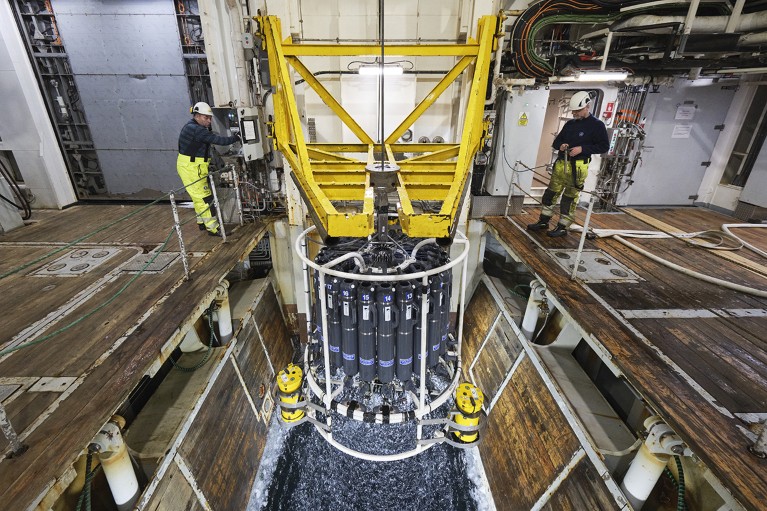
A device called a CTD rosette collects water samples and measures current flows and other properties.Credit: Tim Kalvelage
The layer of relatively warm and salty water is what interests the researchers the most. It is water that had previously flowed north through the Atlantic, taken a U-turn in Fram Strait or made a loop around the Arctic Ocean and is now travelling south in the East Greenland Current. As it continues west of Iceland, the dense subsurface water of this current crosses a marine mountain ridge and cascades down into the abyssal North Atlantic. This makes it a major source for the deep branch of the AMOC and one of the prime subjects that the ROVER project aims to study.
In the past, the East Greenland Current has been fully covered by sea ice in winter, which allowed little heat to escape from the ocean. But with rising temperatures in the past few decades, the wintertime ice cover in this region has been shrinking. This is exposing the East Greenland Current to extremely cold polar air, which could help to spur water to sink — a crucial part of the overturning circulation. For Giorgi, this possibility provides “a glimmer of hope” compared with the mostly gloomy future scenarios of the AMOC.
Våge suggests that deep-water formation driven by intense heat loss in this region could make the AMOC more resilient to climate change than some researchers have assumed. He points to some pilot data from a previous study8 that support his hypothesis of enhanced heat loss along the East Greenland Current. “But we do not know how much or how important it is,” he says.
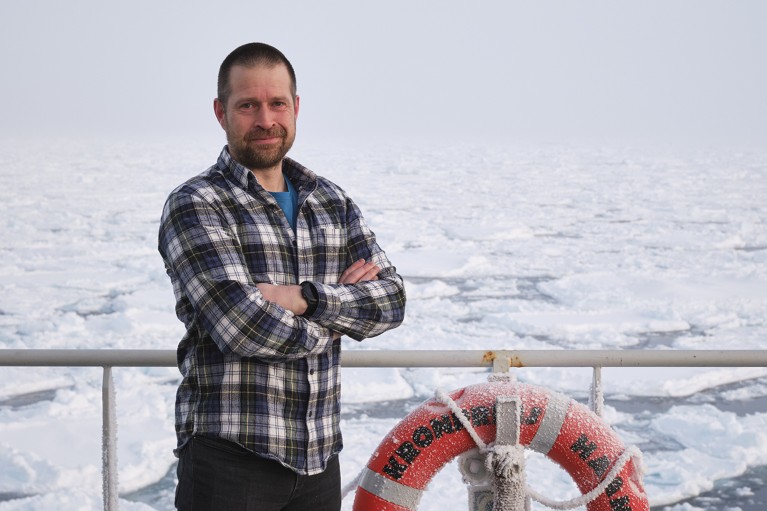
Chief scientist Kjetil Våge on deck in the ice-covered Greenland Sea.Credit: Tim Kalvelage


